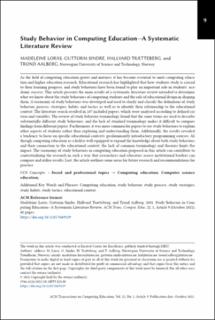| dc.contributor.author | Lorås, Madeleine | |
| dc.contributor.author | Sindre, Guttorm | |
| dc.contributor.author | Trætteberg, Hallvard | |
| dc.contributor.author | Aalberg, Trond | |
| dc.date.accessioned | 2021-11-03T08:45:42Z | |
| dc.date.available | 2021-11-03T08:45:42Z | |
| dc.date.created | 2021-10-21T19:36:42Z | |
| dc.date.issued | 2022 | |
| dc.identifier.issn | 1946-6226 | |
| dc.identifier.uri | https://hdl.handle.net/11250/2827452 | |
| dc.description.abstract | As the field of computing education grows and matures, it has become essential to unite computing education and higher education research. Educational research has highlighted that how students study is crucial to their learning progress, and study behaviors have been found to play an important role in students’ academic success. This article presents the main results of a systematic literature review intended to determine what we know about the study behaviors of computing students and the role of educational design in shaping them. A taxonomy of study behaviors was developed and used to clarify and classify the definitions of study behavior, process, strategies, habits, and tactics as well as to identify their relationship to the educational context. The literature search resulted in 107 included papers, which were analyzed according to defined criteria and variables. The review of study behavior terminology found that the same terms are used to describe substantially different study behaviors, and the lack of standard terminology makes it difficult to compare findings from different papers. Furthermore, it was more common for papers to use study behaviors to explain other aspects of students rather than exploring and understanding them. Additionally, the results revealed a tendency to focus on specific educational contexts, predominantly introductory programming courses. Although computing education as a field is well equipped to expand the knowledge about both study behaviors and their connection to the educational context, the lack of common terminology and theories limits the impact. The taxonomy of study behaviors in computing education proposed in this article can contribute to contextualizing the research in such a way that researchers and educators across institutional borders can compare and utilize results. Last, the article outlines some areas for future research and recommendations for practice. | en_US |
| dc.language.iso | eng | en_US |
| dc.publisher | Association for Computing Machinery (ACM) | en_US |
| dc.relation.uri | https://dl.acm.org/doi/10.1145/3469129 | |
| dc.title | Study Behavior in Computing Education—A Systematic Literature Review | en_US |
| dc.type | Peer reviewed | en_US |
| dc.type | Journal article | en_US |
| dc.description.version | publishedVersion | en_US |
| dc.rights.holder | © 2021 Copyright held by the owner/author(s). | en_US |
| dc.source.volume | 22 | en_US |
| dc.source.journal | ACM Transactions on Computing Education | en_US |
| dc.source.issue | 1 | en_US |
| dc.identifier.doi | https://doi.org/10.1145/3469129 | |
| dc.identifier.cristin | 1947676 | |
| dc.relation.project | Direktoratet for internasjonalisering og kvalitetsutvikling i høgare utdanning: 16/02049 | en_US |
| cristin.ispublished | true | |
| cristin.fulltext | original | |
| cristin.qualitycode | 1 | |
